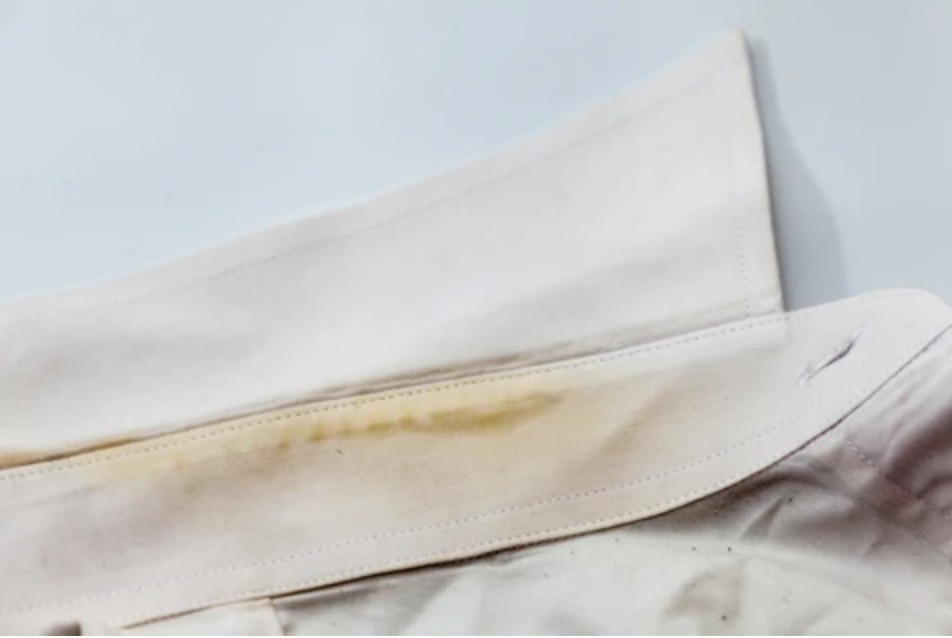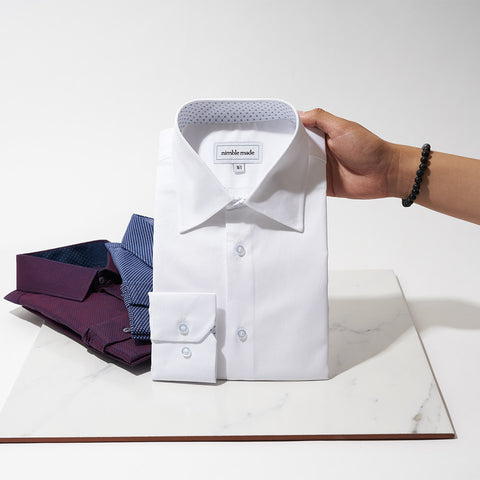
A dress shirt is a staple in any man’s wardrobe. Whether it is for work, a party, or any other formal occasion, a dress shirt is a must.
But even the nicest, most expensive and high-end white dress shirt will look dingy if it has a ring around the collar, a surefire sign that it isn’t properly cared for. Here's a separate guide on how to get stains out of white shirts.
While you know the importance of preventing stains near the sleeve cuff or underarms, people tend to forget to look for an ugly ring around the collar.
Your collar is much harder to cover up than a stain on your sleeve or under your arms. Even a great suit and tie may not be enough to disguise the yellow or brown stained ring around your collar.
To make sure you look your best, rather than looking unclean and unkempt, you need to put your best foot forward and keep your collar free of any stains, or at the very least taking steps to remove the ring around your collar on your dress shirts.
As someone who owns a dress shirt business, I've seen my fair share of stained shirt collars. I'll take you through a few methods on how to remove them.
How to remove the ring around the collar stains
If you have noticed a ring around the collar, there are some things you can do to better treat that collar ring and remove the marks.

Be Vigilant
If you want to prevent stains, it is important to keep an eye out for them. Whether it is during the day while you wear your shirt, or at the end of the day when you take it off, you should take the time to look at your collar.
Look both at the obvious parts of the collar and underneath it to get a full inspection. The sooner you spot a stain ring around the collar, the sooner you can take care of it and the more likely you are to get it out.
Treat It Directly
Rather than just relying on a regular wash cycle to treat the stain, you should use spot treatments. This includes laying the shirt out flat and applying laundry or dish detergent directly around the collar where there is discoloration.
You should allow it to sit for at least a few minutes, then throw it your shirt in the wash as normal.
Use Stain Removers
To better break through tough or old stains, you should also consider using a stain remover. There are plenty of brands on the market to choose from and can get very specific for your needs.
Brands like Oxyclean are famous for their “stain fighting power”, and have many products to tackle a wide range of stains. If you are overwhelmed as to where to start, that is a good option. Here are some of our favorites:
Try Shampoo or Dish Soap
If you are still having trouble getting stains out with standard liquid detergent, you can also try using shampoo or dish soap to wash your collar. Shampoo is ideal for removing stains caused from hair care products, and dish detergent will better break up greasy stains from things like oils.

Make sure that you are using products that will help to remove the stains, rather than add to them, and make sure you avoid putting these materials in your washer like you would detergent. Instead, you should use them as a spot treatment, or pre-wash cleaning to help get the stain loosened up before the wash.
You should always follow this up with a regular cycle through your washer to remove any leftover product.
Soak Old Stains in Vinegar
For older stains, you can use white vinegar to soak the collar and cuff stains before washing. Depending on how old the stain is, you may have to soak it for fifteen minutes to an hour. Then rinse the shirt and wash it as normal. Make sure you are using white vinegar only, or you can end up causing more stains.

Try Aspirin
Another way of breaking up older or more severe stains is aspirin. You can fill a basin with lukewarm water and dissolve some aspirin in it before submerging your shirt. This should be left to soak for around an hour so the aspirin can work through the stain. You should then rinse it and throw the shirt in the wash.
What are the causes of a dress shirt collar stain?
There are several different causes for stains around your dress shirt collar ring. It is important to remember that there may be more than one cause working together to contribute to your collar stains.
Sweat
One of the most common causes of stains on white shirts is sweat. Especially in the warmer months or when under pressure, sweat can quickly build up and seep into your shirt in several spots. Try this non-toxic spot remover laundry spray for sweat stains.
Here's a separate guide we put together labeling the 6 best sweat proof dress shirts. One often overlooked spot when trying to prevent perspiration is the back of the neck, making it easy to absorb and stain your collar.

Skin Cells and Oils
Skin oils and dead skin cells can also build up around your white shirts and collar and collect to form discoloration.
Residue from Hair Products
Hair products can end up in your shirt collar as well. This can occur whether you are getting dressed before applying product, after, or while the hair is touching your collar. The sprays, gels, cremes, oils and balms can all end up in your collar and cause stains and discoloration.
Jewelry
Jewelry like pinky rings may not seem like a major threat to your collars, but oxidation can occur and rub off on your clothing. While jewelry may not be a threat to your clothing initially, you may end up with a problem over time. Especially when the jewelry is made up of certain materials.
Perfume
Perfumes and colognes can soak into your shirt when it is sprayed on the collar. If you spray your skin directly, it may rub off into the collar when wearing your white shirts throughout the day.
While the stain may not immediately show as a problem, building up over time can cause serious stains and discoloration. Here's a guide on how to apply cologne properly while making your smell last long and avoid stains on your clothes.
Food
Everyone will inevitably drop food on their clothing at some point in their life. But if you are unfortunate enough to have dropped food on your collar, it can stain just like anywhere else. These are our favorite food stain remover for clothes
How to prevent it?
It is always better to try to prevent the problem before it happens. Unforutunately with white dress shirts, sometimes stains around the collar on white shirts can be inevitable.
We recommend buying quality white dress shirts that last long and to replace when they've reached the end of their lives. This is one of our favorite 100% cotton slim fit dress shirts for men from Nimble Made:
To help you prevent a stain around your collar, there are certain habits you should practice.
Exfoliate
To help prevent dead skin cells from ending up in your collar, it is recommended that you exfoliate at least once a month. This can be done with a loofah or a washcloth, but it is important to get your entire neck and shoulders.
Avoid Products When Possible
The less product you use, the less product can get into your shirt. If you can cut down on the amount of lotion, moisturizer, makeup, fragrance and hair product, you can greatly eliminate the amount of stains in your collar.
Wear an Undershirt
Undershirts can help to collect the skin cells, oils and sweat from your body before it can get into your dress shirt. While it will not protect your undershirt, this is a good way to keep your dress shirt looking nice.
Consider Your Dress Shirt Choice
You should consider two things when it comes to minimizing stains in your collar. The first is to choose a looser collar to prevent too much rubbing. You should also think about the material of the shirt.
Cotton is a very breathable material that helps promote air flow and prevent sweating. But cotton can also absorb stains more easily.
This is our favorite slim fit white dress shirt for men.
Polyester and poly-blends are much more stain resistant and will better hold up to exposure to products and sweat. If you cannot stop the stains from occurring, you can also consider investing in a dark colored shirt like this sweat-resistant, non-iron black dress shirt.
This will make it much more difficult to see the stains on your collar and will prevent other people from noticing a problem.
Invest in a Collar Protector
Collar protectors are available as well for those who want to guard against stains. While it won’t protect the outside of your collar, it will help protect the interior and keep it clean.
FAQs about how to remove stains in collar
What does "ring around the collar" mean?
"Ring around the collar" refers to a visible stain or discoloration that appears on the collar of a shirt. This often results from a combination of body oils, sweat, and residue from personal care products like deodorants or lotions.
The term became widely known due to its association with laundry problems and was popularized by a series of advertisements in the 1970s.
How do I get rid of the ring around my collar?
To remove a ring around the collar, follow these steps:
-
Pre-treat the Stain: Apply a stain remover or a mixture of baking soda and water directly to the affected area. Let it sit for about 15 minutes.
-
Scrub Gently: Use a soft brush or an old toothbrush to gently scrub the collar. This helps to lift the oils and residue from the fabric.
-
Wash as Usual: Wash the shirt in the warmest water temperature safe for the fabric. (Avoid hot water) Be sure to follow the care instructions on the label.
-
Check Before Drying: After washing, check if the stain is completely gone before drying the shirt. Heat from the dryer can set the stain if it’s not fully removed.
-
Repeat if Necessary: If the stain persists, repeat the pre-treatment and washing steps.
What detergent was "ring around the collar"?
The phrase "ring around the collar" was popularized by a series of advertisements for Wisk, a laundry detergent, in the 1970s. The ads emphasized the effectiveness of Wisk in removing the stubborn stains and rings around collars, highlighting it as a solution to this common laundry problem.
Conclusion
No matter what you do, wear & tear is normal and clothes will get stains, fade and, discolor over time. Refreshing your wardrobe can be a viable solution from time to time. Here's our favorite white dress shirt and undershirt to go with it:











Comments (0)
Back to News